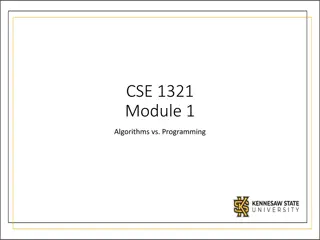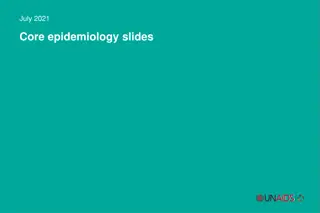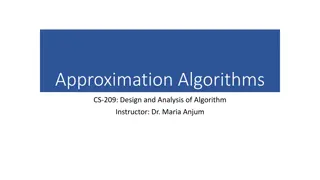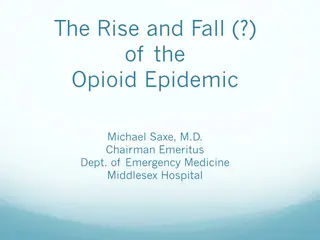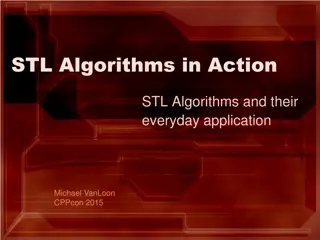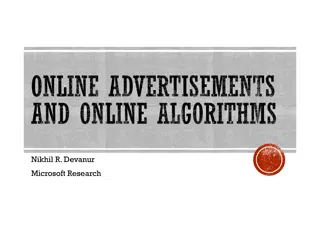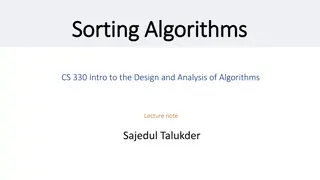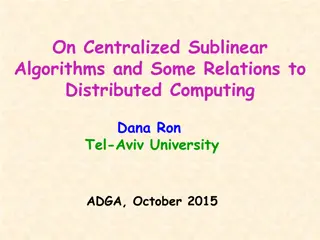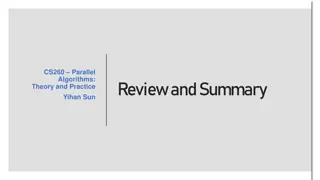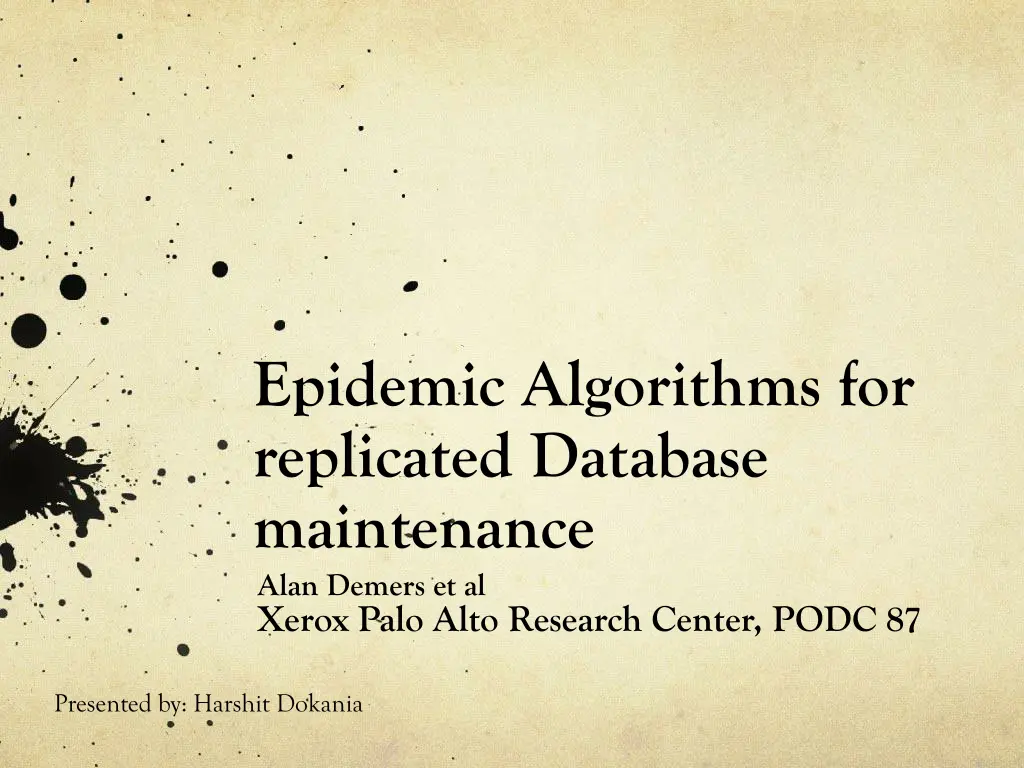
Epidemic Algorithms for Replicated Databases and Maintenance
"Explore the implementation of epidemic algorithms for replicated database maintenance providing faster reads, fault tolerance, and eventual consistency. Learn about the motivation, consistency, updates propagation, and conflict resolution methods in distributed databases."
Download Presentation

Please find below an Image/Link to download the presentation.
The content on the website is provided AS IS for your information and personal use only. It may not be sold, licensed, or shared on other websites without obtaining consent from the author. If you encounter any issues during the download, it is possible that the publisher has removed the file from their server.
You are allowed to download the files provided on this website for personal or commercial use, subject to the condition that they are used lawfully. All files are the property of their respective owners.
The content on the website is provided AS IS for your information and personal use only. It may not be sold, licensed, or shared on other websites without obtaining consent from the author.
E N D
Presentation Transcript
Epidemic Algorithms for replicated Database maintenance Alan Demers et al Xerox Palo Alto Research Center, PODC 87 Presented by: Harshit Dokania
Motivation Replicated Databases Availability, Fault tolerant, Faster reads Consistency EventualConsistency : Epidemic Algorithms Faster reads, writes
Why Consistency ? Replica 1 Replica 3 Replica 2 ACK $50 Add $1000 to John s Account Get John s Balance www.mybank.com $50 Done!! Get my Balance Add $1000 to John s Account How to propagate updates? Ram informs John money has been deposited. Ram John
How to Propagate Updates? Direct Mail Anti-entropy - Simple Epidemic infected or susceptible sites Rumor Mongering Complex Epidemic infected, susceptible and removed Goal: For all s, s S: s.valueOf = s .valueOf
Direct Mail Messages are queued, stable storage Reliable but Not everybody knows everybody Queue overflows Source site = O(n) messages Traffic = # sites * Average distance b/w the sites Anti-Entropy in Background Update[v : V] = s.ValueOf < (v, GMT)
Key (Name) Ram Value (Bal) 6000 Time (GMT) 100 Anti-Entropy Key (Name) Ram Value (Bal) 5000 Time (GMT) 110 John 50 100 Select Random Site Sam 1500 105 John 1050 110 Resolve Conflicts 1 2 Sam 1200 100 Key (Name) Ram Value (Bal) 5000 Time (GMT) 110 Slower than Direct Mail ? Distribute update to few sites 3 John 1050 110 4 Push, Pull, Push - Pull Sam 1500 105
Push vs Pull Pull o pi= Probability of a site remaining susceptible after the ith cycle Only if it Selects susceptible site in i+1st cycle pi+1= (pi)2 0 Push o Only if No infectious site chose to contact susceptible site pi+1= pi(1-1/n)n(1-pi) = pie-1 0(less rapidly) But Anti-Entropy is Expensive!!!
Anti-Entropy is Expensive Usually Databases are in nearly complete agreement o Then why send entire Database across network ? Exchange Database only if checksum of Database disagree o Time to update to all sites > Interval between the updates Recent update list that contains all new changes for time window o t MUST > Time required to distribute the update Exchange recent update list, then compare checksums o Checksums agree, Less traffic, Less Database comparison
Rumor Mongering Removed Infected Susceptible s hot rumor k=1 i(s)=k+1 (1-s)+1 s klogs Convergence, i = 0 s = ? k Residue s = e-(k+1)(1-s) s
Counter vs Probability Become removed after k unnecessary contacts Response and Counters Blind and Probabilistic Counter k Residue s Traffic m Converge tave|tlast 11.0 16.8 12.1 16.9 12.5 17.4 12.7 17.5 12.8 17.7 Counter k Residue s Traffic m Converge tave|tlast 19 38 17 33 15 32 14.1 32 13.8 32 1 2 3 4 5 0.176 0.037 0.011 0.0036 0.0012 1.74 3.30 4.53 5.64 6.68 1 2 3 4 5 0.960 0.205 0.060 0.021 0.008 0.04 1.59 2.82 3.91 4.95 Convergence Residue Traffic Push, RM
Push vs Pull Numerous updates o Susceptible can find infective with high Probability Counter k 1 2 3 Residue s 3.1 *10-7 5.8 *10-4 4.0 * 10-6 Traffic m 2.70 4.49 6.09 Convergenc e tave | tlast 9.97 17.63 10.07 15.39 10.08 14.00 Pull, Response and Counters Exchange countersIf both know the update Increment the site with smaller counter Push gets better than Pull with connection limit. How? Two sites contact the same recipientOne gets rejected Still gets the update Two sites contact the same infected siteOne gets rejectedOnly 1 site updated
Direct Mail vs Rumor Both has no guarantee o - Anti-entropy is the key But what if Anti- entropy finds conflicts ? - Let it be -Clearinghouse uses Direct Mail for redistribution Worst case : DM Manages to deliver an update half the sites Later AE-DM generates O(n2) messages or AE-RM generates O(n) messages o
Key (Name) Ram Value (Bal) 5000 Time (GMT) Key (Name) Ram John Value (Bal) 5000 1050 Time 110 How do we delete? 110 110 Key (Name) Ram Value (Bal) 5000 Time (GMT) 110 Sam Sam 1500 1200 105 100 John 1050 110 1 2 Sam 1200 100 Resurrection with obsolete DB Key (Name) Ram Value (Bal) 5000 Time (GMT) 110 3 Key (Name) Ram Value (Bal) 5000 Time (GMT) 110 4 John 1050 110 Sam 1200 100 Delete my account John 1050 110 Sam 1200 100 John
Key (Name) Ram Value (Bal) 5000 Time Time (GMT) 110 Key (Name) Ram John Value (Bal) 5000 1050 Delete John, 120 Death Certificates 110 110 Key (Name) Ram Ram Value (Bal) 5000 5000 Time Time (GMT) 110 Key (Name) Value (Bal) Sam Sam 1500 1200 105 100 110 Delete John, 120 John Sam 1050 1200 110 100 1 2 Sam 1200 100 But when do we delete Death Certificates Looks Easy !!! 3 Key (Name) Ram Value (Bal) 5000 Time (GMT) 110 4 Delete my account Sam 1200 100 John
Delete Death Certificates Delete them after 30 days o Still has risk of resurrection Sarin and Lynch propose Chandy-Lamport snapshot algorithm o Records Application messages when sees duplicate Marker messages Snapshot ensures Death certificate received at all sites But what when site permanently fails?
Dormant Death Certificates Delete death certificates at most sites o -But retain Dormant death certificates at some retention sites r Obsolete update encounters Dormant certificate Activate Death certificate o -Original timestamp, Activation timestamp Much larger threshold for Dormant Death Certificates o But lost due to permanent server failures o pfail= 2-r
Spatial Distribution Saves significant amount of traffic o probability of connecting site at distance d= d-a o when a = 2 ; convergence is polynomial in log n Generalized for CIN with distribution d-2D dependent on dimension of mesh D Qs(d) = sites at distance d or less from s o arbitrary network Best Scaling
Using Spatial Distribution Anti-Entropy o Uniform distribution 80 conversations on critical links Expected traffic per link per cycle < 6 conversations Qs(d) adapts well to local dimension Rumor Mongering o Making it less sensitive for sudden increases in Qs(d) Each site s builds a list of sites sorted by distance For a = 2 again complexity is O(d-2d)
Simulation Results: AE Push-Pull, No Connection limit Push-Pull, Connection limit 1 Distribution tlast | tave Compare Traffic Avg | Critical 5.87 75.74 2.00 11.19 Distribution tlast | tave Compare Traffic Avg | Critical 3.71 47.54 Uniform a = 1.2 a = 1.4 a = 1.6 a = 1.8 a = 2.0 7.81 5.27 10.04 6.29 10.31 6.39 1.93 8.77 10.94 6.70 11.97 7.21 13.32 7.76 1.36 2.38 Uniform a = 1.2 a = 1.4 a = 1.6 11.00 6.97 16.89 9.92 1.14 6.39 17.34 10.15 19.06 11.06 21.46 12.37 0.82 1.68 24.64 14.14 0.72 0.94 1.08 4.68 0.94 2.90 1.71 5.72 1.52 3.74 a = 1.8 a = 2.0 Increase in convergence < factor of 2 Decrease in Average traffic factor of 4 Frequent anti-entropy Massivedecrease in compare traffic for transatlantic links > factor of 30 Connection limit reduces the compare traffic/cycle but increases the number of cycles
Simulation Results: RM Distribution Compare traffic Avg | Bushey 8.87 114.0 3.20 18.0 2.86 13.0 2.94 9.80 2.40 5.91 1.00 3.44 Update traffic Avg | Bushey 5.84 75.87 2.60 17.25 2.49 14.05 2.27 10.54 2.08 7.69 1.90 5.94 k tlast | tave Uniform a = 1.2 a = 1.4 a = 1.6 a = 1.8 a = 2.0 4 5 6 7 8 9 7.83 5.32 10.14 6.33 10.27 6.31 11.24 6.90 12.04 7.24 13.00 7.74 Feedback, Counter, Push-Pull, No connection limit With increase in a , k increases gradually Convergence time increases Decrease in Average traffic factor of 3 Massivedecrease in compare traffic for transatlantic links > factor of 30
Discussion Anti- Entropy is robust than Rumor Mongering o Rumors may become inactive leaving sites susceptible Push Pull much sensitive to spatial distribution than Push-Pull (RM) o k = 36 for a = 1.2 (Push, Feedback, No connection limit, Counter) Anti - Entropy with distribution of d-2 was implemented at CIN o Massiveimprovement in network load consistency
Cons/Questions Storage, Death Certificates Irregular Network Topologies - Dynamic Hierarchy

